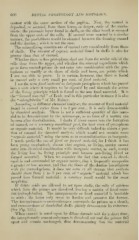Page 590 - My FlipBook
P. 590
600 DENTAL EMBRYOLOGY AND HISTOLOGY.
contact with the outer surface of the papilla.. Now, the enamel is
deposited, or secreted, from these lower, or deeper, ends of the amelo-
blasts ; the prismatic layer found in shells, on the other hand, is secreted
from the upper ends of the cells. If enamel were secreted in a similar
manner, the ameloblasts would be situate
The mineralizing constituents of enamel vary considerably from those
of shells. The amount of organic material found in shells is also far
greater than that of enamel.
Whether there is less protoplasm shed out from the under side of the
cells than from the upper, and whether the mineral ingredients M'hich
go to form enamel-prisms do not enter into combination with the pro-
toplasm as readily as do those of shells and bone, are points which
I am not able to prove. It is certain, however, that there is found
in enamel only a very small per cent, of fixed material.
I use the tcvm fixed material to designate protoplasm which has passed
into a state where it requires to be digested by and through the action
of the living principle which is found in the non-fixed material. It is
the " formed material " of Beale, and in this particular instance it is also
the " calcoglobulin " of Mr. Rainey.
According to different chemical analyses, the amount of fixed material
found in enamel varies from 1 to 3 per cent. ; it is only demonstrable
by chemical analysis. There is not a sufficient quantity of this mate-
rial to be demonstrated by the microscope, as no trace of a matrix can
be seen after decalcification. I doubt if there enters into the formation
of enamel, as a necessary constituent part, the least trace of protoplasm
or organic material. It would be very difficult indeed to obtain a por-
tion of enamel for chemical analysis which would not contain some
^'organic material," using the term as in contradistinction to inorganic.
I nmch prefer the use of fixed or formed material, for I think it has
been pretty conclusively shown that organic, or living, matter cannot
enter into chemical combination with inorganic matter, as such, except
the living lose its living principle and become non-living (fixed or
formed material). When we consider the fact that enamel, is devel-
oped in and surrounded by organic matter, that it frequently encapsules
a greater or less amount, and that the fibres of the dentine interdigitate
with the enamel-prisms, it does not seem at all strange that analysis
should show from 1 to 3 per cent, of "organic" material which has
passed into formed material : a contrary result would be the more
sur]irising.
If dilute acids are allowed to act upon shells, the salts of calcium
which form the prisms are dissolved, leaving a matrix of fixed mate-
rial (calcoglobulin). The intcrprismatic or fixed material is insoluble
in acids ; the latter only serve to harden and preserve the former.
This intcrprismatic cement-substance surrounds the prisms as a sheath,
and cross-sections of decalcified shells plainly demonstrate its existence.
(See Fig. 333.)
When enamel is acted upon by dilute chromic acid for a short time,
the inter])rismatic cement-sul)stan('e- is dissolved out and the prisms fall
apart and remain unchanged, thus demonstrating that the material


